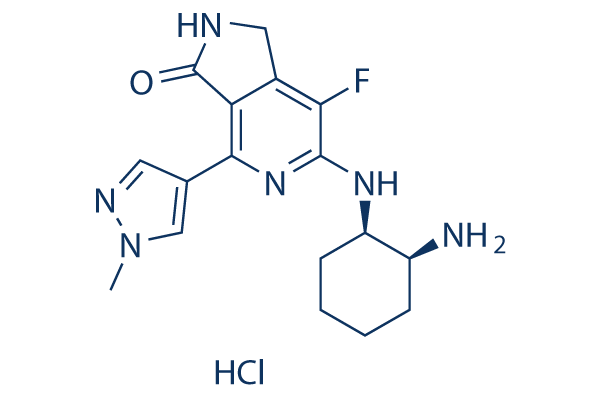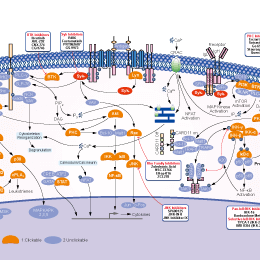
- Bioactive Compounds
- By Signaling Pathways
- PI3K/Akt/mTOR
- Epigenetics
- Methylation
- Immunology & Inflammation
- Protein Tyrosine Kinase
- Angiogenesis
- Apoptosis
- Autophagy
- ER stress & UPR
- JAK/STAT
- MAPK
- Cytoskeletal Signaling
- Cell Cycle
- TGF-beta/Smad
- DNA Damage/DNA Repair
- Compound Libraries
- Popular Compound Libraries
- Customize Library
- Clinical and FDA-approved Related
- Bioactive Compound Libraries
- Inhibitor Related
- Natural Product Related
- Metabolism Related
- Cell Death Related
- By Signaling Pathway
- By Disease
- Anti-infection and Antiviral Related
- Neuronal and Immunology Related
- Fragment and Covalent Related
- FDA-approved Drug Library
- FDA-approved & Passed Phase I Drug Library
- Preclinical/Clinical Compound Library
- Bioactive Compound Library-I
- Bioactive Compound Library-Ⅱ
- Kinase Inhibitor Library
- Express-Pick Library
- Natural Product Library
- Human Endogenous Metabolite Compound Library
- Alkaloid Compound LibraryNew
- Angiogenesis Related compound Library
- Anti-Aging Compound Library
- Anti-alzheimer Disease Compound Library
- Antibiotics compound Library
- Anti-cancer Compound Library
- Anti-cancer Compound Library-Ⅱ
- Anti-cancer Metabolism Compound Library
- Anti-Cardiovascular Disease Compound Library
- Anti-diabetic Compound Library
- Anti-infection Compound Library
- Antioxidant Compound Library
- Anti-parasitic Compound Library
- Antiviral Compound Library
- Apoptosis Compound Library
- Autophagy Compound Library
- Calcium Channel Blocker LibraryNew
- Cambridge Cancer Compound Library
- Carbohydrate Metabolism Compound LibraryNew
- Cell Cycle compound library
- CNS-Penetrant Compound Library
- Covalent Inhibitor Library
- Cytokine Inhibitor LibraryNew
- Cytoskeletal Signaling Pathway Compound Library
- DNA Damage/DNA Repair compound Library
- Drug-like Compound Library
- Endoplasmic Reticulum Stress Compound Library
- Epigenetics Compound Library
- Exosome Secretion Related Compound LibraryNew
- FDA-approved Anticancer Drug LibraryNew
- Ferroptosis Compound Library
- Flavonoid Compound Library
- Fragment Library
- Glutamine Metabolism Compound Library
- Glycolysis Compound Library
- GPCR Compound Library
- Gut Microbial Metabolite Library
- HIF-1 Signaling Pathway Compound Library
- Highly Selective Inhibitor Library
- Histone modification compound library
- HTS Library for Drug Discovery
- Human Hormone Related Compound LibraryNew
- Human Transcription Factor Compound LibraryNew
- Immunology/Inflammation Compound Library
- Inhibitor Library
- Ion Channel Ligand Library
- JAK/STAT compound library
- Lipid Metabolism Compound LibraryNew
- Macrocyclic Compound Library
- MAPK Inhibitor Library
- Medicine Food Homology Compound Library
- Metabolism Compound Library
- Methylation Compound Library
- Mouse Metabolite Compound LibraryNew
- Natural Organic Compound Library
- Neuronal Signaling Compound Library
- NF-κB Signaling Compound Library
- Nucleoside Analogue Library
- Obesity Compound Library
- Oxidative Stress Compound LibraryNew
- Plant Extract Library
- Phenotypic Screening Library
- PI3K/Akt Inhibitor Library
- Protease Inhibitor Library
- Protein-protein Interaction Inhibitor Library
- Pyroptosis Compound Library
- Small Molecule Immuno-Oncology Compound Library
- Mitochondria-Targeted Compound LibraryNew
- Stem Cell Differentiation Compound LibraryNew
- Stem Cell Signaling Compound Library
- Natural Phenol Compound LibraryNew
- Natural Terpenoid Compound LibraryNew
- TGF-beta/Smad compound library
- Traditional Chinese Medicine Library
- Tyrosine Kinase Inhibitor Library
- Ubiquitination Compound Library
-
Cherry Picking
You can personalize your library with chemicals from within Selleck's inventory. Build the right library for your research endeavors by choosing from compounds in all of our available libraries.
Please contact us at [email protected] to customize your library.
You could select:
- Antibodies
- Bioreagents
- qPCR
- 2x SYBR Green qPCR Master Mix
- 2x SYBR Green qPCR Master Mix(Low ROX)
- 2x SYBR Green qPCR Master Mix(High ROX)
- Protein Assay
- Protein A/G Magnetic Beads for IP
- Anti-Flag magnetic beads
- Anti-Flag Affinity Gel
- Anti-Myc magnetic beads
- Anti-HA magnetic beads
- Magnetic Separator
- Poly DYKDDDDK Tag Peptide lyophilized powder
- Protease Inhibitor Cocktail
- Protease Inhibitor Cocktail (EDTA-Free, 100X in DMSO)
- Phosphatase Inhibitor Cocktail (2 Tubes, 100X)
- Cell Biology
- Cell Counting Kit-8 (CCK-8)
- Animal Experiment
- Mouse Direct PCR Kit (For Genotyping)
- New Products
- Contact Us
TAK-659 Hydrochloride
TAK-659 Hydrochloride is a potent and selective inhibitor of spleen tyrosine kinase (SYK) with an IC50 value of 3.2 nM. It is selective against most other kinases, but potent toward both SYK and FLT3.

TAK-659 Hydrochloride Chemical Structure
CAS No. 1952251-28-3
Purity & Quality Control
Batch:
Purity:
99.65%
99.65
TAK-659 Hydrochloride Related Products
| Related Targets | ZAP70 | Click to Expand |
|---|---|---|
| Related Products | R406 R406 (free base) PRT062607 (P505-15) HCl Entospletinib (GS-9973) Piceatannol BAY-61-3606 PRT-060318 2HCl RO9021 | Click to Expand |
| Related Compound Libraries | Tyrosine Kinase Inhibitor Library PI3K/Akt Inhibitor Library Angiogenesis Related compound Library HIF-1 Signaling Pathway Compound Library FDA-approved Anticancer Drug Library | Click to Expand |
Signaling Pathway
Biological Activity
| Description | TAK-659 Hydrochloride is a potent and selective inhibitor of spleen tyrosine kinase (SYK) with an IC50 value of 3.2 nM. It is selective against most other kinases, but potent toward both SYK and FLT3. | ||||||||||
|---|---|---|---|---|---|---|---|---|---|---|---|
| Targets |
|
| In vitro | ||||
| In vitro | In a cell proliferation assay, TAK-659 shows inhibition toward a SYK-dependent cell line (OCI-LY10). the sensitivity to TAK-659 is associated with mutations impacting SYK activity in B cell lymphomas, whereas TAK-659 is not cytotoxic for adherent primary or solid tumor cell lines. In cell viability assays, TAK-659 is shown to be sensitive toward FLT3-ITD dependent cell lines, MV4-11 and MOLM-13 while the WT FLT3 RS4-11 (ALL cell line) and RA1 (Burkitt's Lymphoma cell line) are not sensitive toward TAK-659[1]. In cultured human tumor cells, TAK-659 potently inhibits the growth of hematopoietic-derived cell lines, with a concentration producing half-maximal response (EC50) ranging from 11 to 775 nM in sensitive cell systems (eg, diffuse large B-cell lymphoma, and AML). In a broad kinase panel, TAK-659 demonstrates a more than 50-fold selectivity for SYK and FLT-3 over 290 other protein kinases[2]. Treatment with TAK-659 inhibits Syk activation and BCR signaling in co-cultured primary CLL cells and Burkitt's lymphoma cells. In primary CLL cells in suspension culture, TAK-659 treatment results in a dose-dependent reduction in the phosphorylation of SykTyr525, Btk, NFκB, ERK1/2 and STAT3 after BCR stimulation. Inhibition of Syk by TAK-659 induces apoptosis of CLL cells and abrogates BCR and co-culture-derived survival signals. TAK-659 inhibits chemotaxis toward BMSC, CXCL12 and CXCL13 in primary CLL cells, and abrogates microenvironment-induced chemoresistance. TAK-659 does not inhibit TCR signaling and molecular features of T cell activation in primary T cells from patients with CLL[3]. | |||
|---|---|---|---|---|
| Cell Research | Cell lines | FLT3-dependent cell lines (MV4-11 and MOLM-13) | ||
| Concentrations | -- | |||
| Incubation Time | 72 or 96 hours | |||
| Method | Cells are maintained at 37°C in a humidified atmosphere containing 5-8% CO2. In a panel of hematological and solid tumor cell lines, inhibition of cell viability is determined using the soluble tetrazolium salt, MTS. Cells are seeded in 96-well tissue culture plates and are incubated at 37°C/5% CO2 for 24 hours prior to addition of compounds or DMSO vehicle. After 72 or 96 hours of incubation with compounds, MTS conversion by metabolically active cells is determined by measuring the OD490 nm of the wells using a Thermomax microplate reader. To generate concentration-response curves, cells are treated in duplicate with a range of serial compound dilutions. Prior to addition to cells, compound dilutions are prepared in DMSO. Equal amounts of DMSO are added to cells (final concentration is 0.5%). After background correction and normalization against DMSO-treated cells, EC50 values are calculated by curve-fitting these cell viability results using nonlinear regression analysis. |
|||
| In Vivo | ||
| In vivo | TAK-659 blocks anti-IgD (immune-globulin D antibody) stimulated CD86 expression in mouse peripheral B cells in vivo. In the FLT3-dependent MV4-11 xenograft model, TAK-659 shows tumor regression at 60 mg/kg daily after 20 days of dosing[1]. Preliminary plasma and urine PK data show that TAK-659 was absorbed quickly (median Tmax 2-3 hrs), with moderate variability in steady-state exposures (40-50% CV for DN-AUCtau), mean peak/trough ratio of 3.2–4.2, and mean accumulation of 2.1- to 2.6-fold after 15 d QD dosing. Renal clearance (CLr) of unchanged drug accounts for 30–34% of apparent oral clearance, suggesting a CLr contribution of ≥30–34% to TAK-659 systemic clearance. Oral TAK-659 has an acceptable PK and safety profile in pts with solid tumors or lymphoma, supporting continuous oral QD dosing[4]. | |
|---|---|---|
| Animal Research | Animal Models | Athymic nude mice |
| Dosages | 10, 30, 60 mg/kg QD | |
| Administration | by oral gavage | |
| NCT Number | Recruitment | Conditions | Sponsor/Collaborators | Start Date | Phases |
|---|---|---|---|---|---|
| NCT03772288 | Withdrawn | Lymphoma Non-Hodgkin |
Calithera Biosciences Inc|Nektar Therapeutics |
April 3 2019 | Phase 1 |
| NCT03338881 | Withdrawn | Advanced Solid Neoplasms|Lymphoma Neoplasms |
Calithera Biosciences Inc |
May 10 2018 | Phase 1 |
| NCT03359733 | Withdrawn | Lymphoma Malignant|Advanced Solid Neoplasms |
Calithera Biosciences Inc |
February 28 2018 | Phase 1 |
| NCT03357627 | Completed | Lymphoma Non-Hodgkin|Lymphoma Large B-cell Diffuse|Lymphoma Follicular |
Calithera Biosciences Inc |
February 16 2018 | Phase 1 |
| NCT03123393 | Terminated | Diffuse Large B-cell Lymphoma |
Calithera Biosciences Inc |
October 10 2017 | Phase 2 |
Chemical Information & Solubility
| Molecular Weight | 380.85 | Formula | C17H21FN6 .HCl |
| CAS No. | 1952251-28-3 | SDF | Download TAK-659 Hydrochloride SDF |
| Smiles | CN1C=C(C=N1)C2=NC(=C(C3=C2C(=O)NC3)F)NC4CCCCC4N.Cl | ||
| Storage (From the date of receipt) | |||
|
In vitro |
Water : 2 mg/mL DMSO : Insoluble ( Moisture-absorbing DMSO reduces solubility. Please use fresh DMSO.) Ethanol : Insoluble |
Molecular Weight Calculator |
|
In vivo Add solvents to the product individually and in order. |
In vivo Formulation Calculator |
||||
Preparing Stock Solutions
Molarity Calculator
In vivo Formulation Calculator (Clear solution)
Step 1: Enter information below (Recommended: An additional animal making an allowance for loss during the experiment)
mg/kg
g
μL
Step 2: Enter the in vivo formulation (This is only the calculator, not formulation. Please contact us first if there is no in vivo formulation at the solubility Section.)
% DMSO
%
% Tween 80
% ddH2O
%DMSO
%
Calculation results:
Working concentration: mg/ml;
Method for preparing DMSO master liquid: mg drug pre-dissolved in μL DMSO ( Master liquid concentration mg/mL, Please contact us first if the concentration exceeds the DMSO solubility of the batch of drug. )
Method for preparing in vivo formulation: Take μL DMSO master liquid, next addμL PEG300, mix and clarify, next addμL Tween 80, mix and clarify, next add μL ddH2O, mix and clarify.
Method for preparing in vivo formulation: Take μL DMSO master liquid, next add μL Corn oil, mix and clarify.
Note: 1. Please make sure the liquid is clear before adding the next solvent.
2. Be sure to add the solvent(s) in order. You must ensure that the solution obtained, in the previous addition, is a clear solution before proceeding to add the next solvent. Physical methods such
as vortex, ultrasound or hot water bath can be used to aid dissolving.
Tech Support
Answers to questions you may have can be found in the inhibitor handling instructions. Topics include how to prepare stock solutions, how to store inhibitors, and issues that need special attention for cell-based assays and animal experiments.
Tel: +1-832-582-8158 Ext:3
If you have any other enquiries, please leave a message.
* Indicates a Required Field
Tags: buy TAK-659 Hydrochloride | TAK-659 Hydrochloride supplier | purchase TAK-659 Hydrochloride | TAK-659 Hydrochloride cost | TAK-659 Hydrochloride manufacturer | order TAK-659 Hydrochloride | TAK-659 Hydrochloride distributor







































